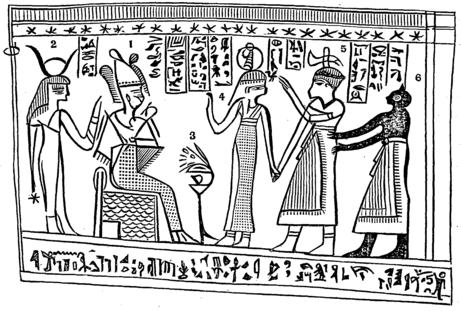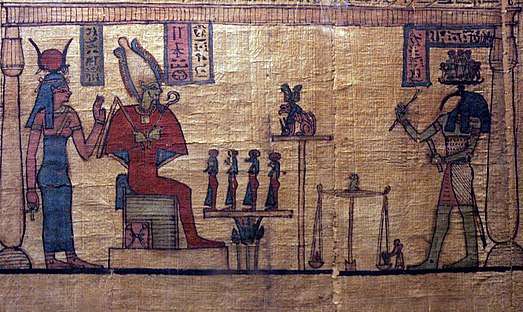Critical appraisal of the Book of Abraham
The Book of Abraham is a work produced between 1835 and 1842 by the Latter Day Saints (LDS) movement founder Joseph Smith that he said was based on Egyptian papyri purchased from a traveling mummy exhibition. According to Smith, the book was "a translation of some ancient records ... purporting to be the writings of Abraham, while he was in Egypt, called the Book of Abraham, written by his own hand, upon papyrus".[1] The work was first published in 1842 and today is a canonical part of the Pearl of Great Price. Since its printing, the Book of Abraham has been a source of controversy. Non-LDS Egyptologists, beginning in the late-19th century, have heavily criticized Joseph Smith's explanations of the facsimiles, with many stating that his interpretations are entirely inaccurate. They have also asserted that damaged portions of the papyri have been reconstructed incorrectly.
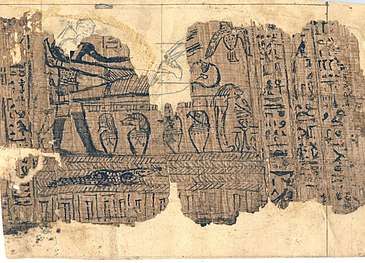
The controversy intensified in the late 1960s when portions of the Joseph Smith Papyri were located. Translations of the papyri revealed the rediscovered portions bore no relation to the Book of Abraham text. LDS apologist Hugh Nibley and Brigham Young University Egyptologists John L. Gee and Michael D. Rhodes subsequently offered detailed rebuttals to some criticisms. University of Chicago Egyptologist Robert K. Ritner concluded in 2014 that the source of the Book of Abraham "is the 'Breathing Permit of Hôr,' misunderstood and mistranslated by Joseph Smith."[2] He later said the Book of Abraham is now "confirmed as a perhaps well-meaning, but erroneous invention by Joseph Smith," and "despite its inauthenticity as a genuine historical narrative, the Book of Abraham remains a valuable witness to early American religious history and to the recourse to ancient texts as sources of modern religious faith and speculation."[2]
Background
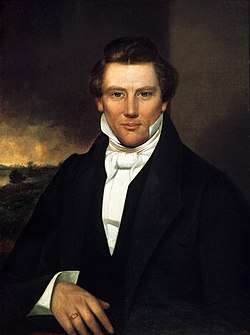
The Book of Abraham is an 1835 work produced by Latter Day Saints (LDS) movement founder Joseph Smith[3] that he claimed were translated from Egyptian papyri purchased from a traveling mummy exhibition. According to Smith, the book comprised "ancient records ... purporting to be the writings of Abraham, while he was in Egypt, called the Book of Abraham, written by his own hand, upon papyrus".[1] The book has five chapters,[4] and is often accompanied by three "facsimiles", or reproductions of vignettes which were copied from the original papyri.[5][6] According to Smith's explanations, Facsimile No. 1 depicts Abraham bound to a sacrificial altar, with the "idolatrous priest of Elkenah" looming over him with a knife;[7] Facsimile No. 2 is a circular depiction of the heavens (featuring planets, stars, the sun and moon, and other celestial objects) that also contains the grand key-words of the holy priesthood;[8] and Facsimile No. 3 portrays Abraham in the court of Pharaoh "reasoning upon the principles of Astronomy".[9]
Of note, the Book of Abraham text is a source for a number of distinct Latter Day Saint doctrines, which Mormon author Randal S. Chase calls "truths of the gospel of Jesus Christ that were previously unknown to Church members of Joseph Smith's day."[10] Examples include the nature of the priesthood,[11] an understanding of the cosmos,[12] the exaltation of humanity,[13] pre-mortal existence and the first and second estates,[14] and the plurality of gods.[15]
Discovery of papyri and their sale to Joseph Smith
Sometime between 1817 and 1822, the Italian adventurer Antonio Lebolo was excavating tombs in the ancient Egyptian city of Thebes, where he discovered, among other things, several tattered fragments of papyri and eleven mummies. Following Lebolo's death in 1830, these finds were shipped to New York with instructions that they should be sold in order to benefit the bereft heirs of Lebolo.[16] Michael H. Chandler eventually purchased the mummies and papyri and began displaying them as curiosities, starting in Philadelphia.[17] Over the next two years Chandler toured the eastern United States with his novelties, selling some of the mummies as he traveled.[18][19]
On June 30, 1835, Chandler exhibited his collection in Kirtland, Ohio.[20] At the time, Kirtland was the home of the Latter Day Saints, led by Joseph Smith, who claimed to have translated a religious text called the Book of Mormon; Smith claimed that this work had been inscribed on a golden plates (given to him by the Angel Moroni) in a mysterious language known as "reformed Egyptian".[21][22] Chandler advertised his wares to those in Kirtland by creating a leaflet that sensationally proclaimed that the mummies "may have lived in the days of Jacob, Moses, or David".[20] This claim caught Smith's attention, and he soon examined the scrolls,[21] claiming that they contained the writings of Abraham and Joseph (as well as a story about an "Egyptian princess" named "Katumin" or "Kah tou mun").[23] He wrote: "[W]ith W. W. Phelps and Oliver Cowdery as scribes, I commenced the translation of some of the characters or hieroglyphics, and much to our joy found that one of the rolls contained the writings of Abraham, another the writings of Joseph of Egypt, etc. – a more full account of which will appear in its place, as I proceed to examine or unfold them."[19]
Smith, Joseph Coe, and Simeon Andrews soon purchased the four mummies and papyrus documents for $2,400 (approximately $58,000 in 2018 dollars).[21][24] In October 1835, Smith, along with Cowdery and Phelps, began "translating an alphabet to the Book of Abraham, and arranging a grammar of the Egyptian language as practiced by the ancients."[25][26][27] The attempted translation process was documented in a collection of manuscripts now known as the Kirtland Egyptian papers.[27][28] The first part of this collection focuses almost entirely on Smith's attempt to decipher the Egyptian characters, and the second part details a unique form of astronomy that, according to Smith, was of ancient Egyptian origin.[29] Most of these documents were penned in July 1835, not by Smith, but rather by a scribe transcribing what Smith spoke aloud.[27] One of the manuscripts in this collection was a bound book simply titled "Grammar & A[l]phabet of the Egyptian Language", which contained Smith's interpretations of the Egyptian glyphs.[30][28] This manuscript is important because it illustrates how Smith attempted to translate the papyri: The scribes sketched out the hieroglyphic characters from the papyri onto the left-hand side of the manuscript. Smith then attempted to give an English translation of the glyph, along with an explanation for how one would pronounce the character.[29]
It seems Smith believed and taught that the papyri had been written by Biblical patriarchs themselves, and not by a later Egyptian scribe or a Jewish redactor.[31] In the article "Truth Will Prevail" published in the Latter Day Saint movement newspaper Times and Seasons, Smith wrote, "The Book of Abraham [was] written by his [i.e. Abraham's] own hand, upon papyrus".[1] Furthermore, Josiah Quincy contended that upon a meeting with Smith, "some parchments inscribed with hieroglyphics were then offered us. They were preserved under glass and handled with great respect. 'That is the handwriting of Abraham, the father of the Faithful,' said the prophet."[31]
By October 1835, Smith believed that he had successfully deciphered the Egyptian alphabet, and so he began his attempt to translate the papyri fragments; the majority of the Book of Abraham was subsequently compiled in November 1835, with minor revisions made in March 1842.[32][33] When translating the book, Smith dictated, and Warren Parrish, Phelps, and Frederick G. Williams served as his scribes.[34] Smith translated the papyri by using five "degrees" of interpretation, with each "degree" representing a deeper, expanded, and more complex level of interpretation.[29] The complete work was first published serially in Times and Seasons in 1842,[nb 1] and it was later canonized in 1880 by the LDS Church as part of its Pearl of Great Price.[3]
The fate of the papyri after Smith's death
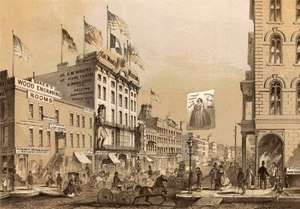
After Joseph Smith's death, the Egyptian artifacts fell into the hands of his mother, Lucy Mack Smith, and brother, William Smith, who "periodically" exhibited the relics to visitors.[6] In May 1856, Lucy died, and on the 26th of that month, Emma Hale Smith Bidamon (Smith's widow), Lewis C. Bidamon (Emma's second husband),[nb 2] and Joseph Smith III, sold "four Egyptian mummies with the records with them" to Abel Combs.[6][37][38] Combs himself later sold "two of [the] mummies, and some of the papyri", to the St. Louis Museum in 1856.[36] Upon the closing of the St. Louis Museum in the 1860s, these artifacts were purchased by Col. John H. Wood and found their way to his museum in Chicago, c. 1863.[38][39] Wood was particularly proud of these objects and had them prominently displayed for all to see. Unfortunately, the museum and all its contents were destroyed in 1871 during the Great Chicago Fire,[36][39][40] and today, it is presumed the papyri which formed the bases for Facsimiles 2 and 3 were lost in this inferno.[36][40]
After the fire, however, it was believed that all the papyri sources for the book had been lost.[41] Unbeknownst to most, Abel Combs still owned several papyri fragments and two mummies (of the latter have disappeared without a trace). The papyri were given to Combs' nurse Charlotte Benecke Weaver upon his death, who in turn gave them to her daughter, Alice Heusser. In 1918, Heusser tried to sell the artifacts to the New York Metropolitan Museum of Art (MMA), but they declined her offer. Then, in 1947, the museum decided that they were interested in acquiring the finds, and they subsequently bought the papyri from Alice's husband, Edward.[42] In May 1966, the coptic scholar Aziz S. Atiya was perusing the museum's collection came across the Heusser fragments; he quickly recognized one as the vignette known as Facsmile 1 from The Pearl of Great Price.[42][43] He informed LDS Church leaders, and several months later, on November 27, 1967, an anonymous donor purchased the fragments and gave them to the LDS Church.[42][43] In the end, the church acquired eleven pieces of papyri, including the original of Facsimile 1.[44]
Three of these fragments were designated Joseph Smith Papyri (JSP) I, X, and XI.[45] Other fragments, designated JSP II, IV, V, VI, VII, and VIII, are thought by critics to be the book of Joseph to which Smith referred when first examining the text. Egyptologist John A. Wilson stated that the recovered fragments indicate the existence of at least six to eight separate documents.[46] The twelfth fragment was discovered in the LDS Church Historian's office and was dubbed the "Church Historian's Fragment". Disclosed by the church in 1968, the fragment was designated JSP IX by scholars.[47] Although there is some debate about how much of the papyrus collection is missing, there is broad agreement that the recovered papyri are indeed portions of Smith's original purchase, partly based on the fact that they were pasted onto paper which had "drawings of a temple and maps of the Kirtland, Ohio area" on the back, as well as the fact that they were accompanied by an affidavit by Emma Smith, stating that they had been in the possession of Joseph Smith.[48]
Analysis and translation of the papyrus by Egyptologists
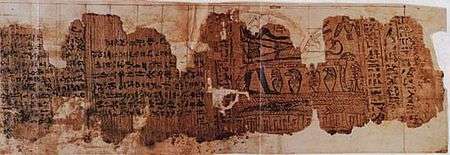
In November 1967, the LDS Church asked Hugh Nibley, a professor of ancient scripture at Brigham Young University (BYU), to study the fragments. Although competent in numerous languages, Nibley did not have a working knowledge of the ancient Egyptian script or language, so he studied under the University of Chicago professor John A. Wilson so that he could translate the papyri himself.[49]
The LDS Church published sepia photographs of the papyri in its magazine Improvement Era in February 1968. Although a translation was not provided by the church at this time,[40][50][51] soon thereafter the editors of an independent quarterly journal Dialogue: A Journal of Mormon Thought published their own translation after consulting with several Egyptologists and scholars, including: Klaus Baer, a researcher at the University of Chicago's Oriental Institute; Richard Anthony Parker, the Director of the Department of Egyptology at Brown University; Jerald Tanner, an independent scholar; and John A. Wilson, the director of the Oriental Institute.[40][52][53][54] Since 1968, numerous other translations have also been published by Mormon and non-Mormon scholars, including Michael D. Rhodes (BYU),[55] John Gee (BYU),[56] and Robert K. Ritner (University of Chicago).[57]
The translation by both Mormon and non-Mormon Egyptologists is completely at odds with Joseph Smith's purported translation.[58] The transliterated text from the recovered papyri and facsimiles published in the Book of Abraham contain no direct references—either historical or textual—to Abraham at all,[41][59] and the patriarch's name does not appear anywhere on the papyri or the facsimiles. Edward Ashment notes, "The sign that Smith identified with Abraham ... is nothing more than the hieratic version of ... a 'w' in Egyptian. It has no phonetic or semantic relationship to [Smith's] 'Ah-broam.'"[59] BYU scholar Michael Rhodes summarized the content of the papyri as follows:
The Hor Book of Breathings" is a part of eleven papyri fragments ... from three separate papyri scrolls. Joseph Smith Papyri I, X, and XI are from the Book of Breathings belonging to Hor (Hr) the son of Usirwer. Joseph Smith Papyri II, IV, V, VI, VII, and IX all came from a Book of the Dead belonging to Tshemmim (Ts-sri.t Min.), the daughter of Eskhons (Ns-Hnsw). Finally, Joseph Smith Papyrus III is part of Chapter 125 of the Book of the Dead belonging to Neferirtnub (Nfr-ir(.t)-nbw).[60]
Examining JSP I, Egyptologist Klaus Baer translated the writing on the right of the vignette as follows:
[T]he prophet of Amonrasonter, prophet [?] of Min Bull-of-his-Mother, prophet [?] of Khons the Governor ... Hor, justified, son of the holder of the same titles, master of secrets, and purifier of the gods Osorwer, justified [?] ... Tikhebyt, justified. May your ba live among them, and may you be buried in the West ... May you give him a good, splendid burial on the West of Thebes just like ...[61]
The hieratic text found to the left of the vignette (i.e. the "Small Sensen" text) on JSP I was initially translated by Parker. His translation is as follows:
[T]his great pool of Khonsu [Osiris Hor, justified], born of Taykhebyt, a man likewise. After (his) two arms are [fast]ened to his breast, one wraps the Book of Breathings, which is with writing both inside and outside of it, with royal linen, it being placed (at) his left arm near his heart, this having been done at his wrapping and outside it. If this book be recited for him, then he will breathe like the soul[s of the gods] for ever and ever.[62]
Scholars have dated the Joseph Smith Papyri to the late Ptolemaic period (c. 150 BC), 1500 years after Abraham's supposed lifetime.[41][63][64][65][66] This fact—combined with the presence of apparent anachronisms within the book itself[nb 3]—seems to contradict Smith's statements that the papyri features the "handwriting of Abraham" which had been "written by his own hand".[68]
Sources
Egyptologists have concluded that the papyri fragments were originally part of the following sources:
| Fragment no.[69] | Egyptian source[70] | Composition date[44] | Status[71] |
|---|---|---|---|
| Joseph Smith Papyri (JSP): I (source of Facsimile No. 1), part of IV, X, XI | "Book of Breathing", papyrus of Hôr | c. 150 BC | Owned by the LDS Church |
| JSP: II, IV, V, VI, VII, VIII, IX | "Book of the Dead", papyrus of Ta-sherit-Min | After 500 BC | Owned by the LDS Church |
| JSP: III a–b | "Book of the Dead", papyrus of Nefer-ir-nebu | After 500 BC | Owned by the LDS Church |
| Source of Facsimile No. 2 | Hypocephalus of Sheshonq | Unknown | Presumed lost in the Great Chicago Fire; reproduction of the Hypocephalus of Sheshonq included in the Kirtland Egyptian papers |
| Source of Facsimile No. 3 | "Book of Breathing", papyrus of Hôr | c. 150 BC | Presumed lost in the Great Chicago Fire |
Criticism of the book
The "Egyptian Alphabet and Grammar"
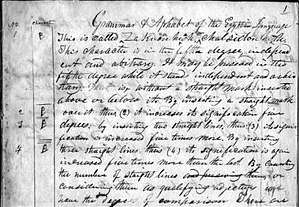
Several criticisms of the Book of Abraham have been brought forth that hinge on evidence found in the "Egyptian Alphabet and Grammar". One such argument focuses on the aforementioned document and its connection to Joseph Smith Papyrus XI, also known as the "Small Sensen" papyrus (i.e. the small scrap of papyrus attached to left side of JSP I).[72] Several pages in the "Egyptian Alphabet and Grammar" contain an arrangement of correlated characters from the Small Sensen papyrus. These pages are divided into two halves: on the left-hand side of a given page, Egyptian characters are listed, and on the right side, an apparent translation of these characters is given.[29][73] This suggests that whoever created the correlation was attempting to perform a direct, literal, and comprehensive translation (as opposed to a merely spiritual or divined translation, as some apologists contend) of the figures of the papyri scraps.[31]
While the "Egyptian Alphabet and Grammar" only contains an explicit correlation between Egyptian characters[nb 4] and their purported English translation for Abraham 1:11–2:9, the document itself suggests that the hieroglyphs from the Small Sensen papyrus were used to translate much of the Book of Abraham.[72] This is supported by a quote from James Ratcliffe Clark, the author of the 1955 book the Story of the Pearl of Great Price, who wrote: "I have in my possession a photostatic copy of the manuscript of the Prophet Joseph Smith's translation of Abraham 1:1 to 2:18. ... The characters from which our present Book of Abraham was translated are down to the left-hand column and Joseph Smith's translation opposite, so we know approximately how much material was translated from each character."[75]
This correlation found in the "Egyptian Alphabet and Grammar" between Abraham 1:11–2:9 and the Small Sensen papyrus has thus led many critics to assert that all of the Book of Abraham text most likely came entirely from Smith's interpretation of the Small Sensen papyrus, rather than a hypothetical lost section (as is often asserted by apologists).[72][76] This means, however, that Smith likely used a single Egyptian character to derive dozens of words. Jerald Tanner, for instance, wrote "Joseph Smith apparently translated many English words from each Egyptian character. The characters from fewer than four lines of the papyrus make up forty-nine verses of the Book of Abraham, containing more than two thousand words. If Joseph Smith continued to translate the same number of English words from each Egyptian character, this one small fragment would complete the entire text of the Book of Abraham. In other words, the small piece of papyrus [i.e. the fragment known as Fragment XI] appears to be the whole Book of Abraham!"[75]
The facsimiles
Early criticism of the facsimiles

In 1856, Gustav Seyffarth viewed the Joseph Smith Papyri at the St. Louis Museum, making the following statement regarding them: "The papyrus roll is not a record but an invocation to the Deity Osirus [sic], in which occurs the name of the person, and a picture of the attendant spirits, introducing the dead to the Judge, Osiris."[36] Later that same year, a pamphlet containing the Book of Abraham's facsimiles was sent to the Louvre. Here, Theodule Deveria, an Egyptologist at the museum, had the opportunity to examine the facsimiles, which he recognized as "common Egyptian funerary documents, of which he had examined hundreds."[77] He argued that many of the hieroglyphic characters had been poorly transcribed and that several areas in the facsimiles seemed to have been reconstructed based on guesswork. Deveria consequently concluded that Joseph Smith's explanation was "rambling nonsense."[77] Despite this condemnation, the LDS Church did not respond to Deveria's critiques at the time.[78] Then, in 1873, Deveria's interpretation, juxtaposed with Smith's interpretation, was published in T. B. H. Stenhouse's book The Rocky Mountain Saints: A Full and Complete History of the Mormons, a work critical of the LDS Church.[79] This time, the church responded by reiterating that the Book of Mormon was divinely inspired, and that the Book of Abraham's source papyri likely had "two meanings" (one that was obvious and easily understood by to a lay audience, and another that was more esoteric and only accessible to the priesthood). In 1880, the Book of Abraham was officially canonized by the Church.[80]
Several decades later, in 1912, Episcopal Bishop Franklin S. Spalding sent copies of the three facsimiles to eight Egyptologists and semitists,[nb 5] soliciting their interpretation of the facsimiles; the results were published in a pamphlet entitled, Joseph Smith, Jr. as a Translator: An Inquiry. The eight scholars wrote that the images were taken from standard funerary documents, and some of the scholars even harshly criticized Smith's interpretation.[82] Egyptologist James H. Breasted of the University of Chicago, for instance, noted: "[T]hese three facsimiles of Egyptian documents in the 'Pearl of Great Price' depict the most common objects in the Mortuary religion of Egypt. Joseph Smith's interpretations of them as part of a unique revelation through Abraham, therefore, very clearly demonstrates that he was totally unacquainted with the significance of these documents and absolutely ignorant of the simplest facts of Egyptian writing and civilization."[83] Flinders Petrie of London University wrote: "It may be safely said that there is not one single word that is true in these explanations".[84] Finally, Archibald Sayce, Oxford professor of Egyptology, stated: "It is difficult to deal seriously with Joseph Smith's impudent fraud ... Smith has turned the goddess [Isis in Facsimile No. 3] into a king and Osiris into Abraham."[85]
Once again, the LDS Church defended the legitimacy of the book, this time by arguing that these scholars were employing improper methods and faulty reasoning. LDS apologists argued that, because many of the Egyptian experts had pointed out that the facsimiles were reminiscent of similar documents, or that certain areas on the facsimiles appeared different from known funerary texts, these scholars were merely ignoring potentially key differences in the facsimiles so that their arguments might seem effective. Such a line of reasoning is exemplified by a note written by Church historian B. H. Roberts: "Yes, or some other change might be suggested, and by such a process some other meaning may be read into the place and make it different from the translation of Joseph Smith."[86] The Church eventually hired an individual named Robert C. Webb (the pen name of J. E. Homans), to defend the veracity of the Book of Abraham. In his 1915 work The Case Against Mormonism (in which he claimed to have a PhD, despite this being a lie), he collected several interpretations of Facsimile No. 1 from Egyptologists that sounded unrelated to the layperson (i.e. that the facsimile represented: "an embalming", "the Resurrection of Osiris", or "Anubis guarding the embalmed mummy") and claimed: "If any of these Egyptologists is right, therefore, this drawing must have been radically altered in several essential particulars. In view of their disagreements, it will be necessary to demonstrate any conclusions drawn. Will some learned person be pleased to tell us what this scene represents? Otherwise, how can we condemn Joseph Smith for 'fraud'...?"[87]
Facsimile No. 1
Joseph Smith claimed that Facsimile No. 1 portrays Abraham on an altar, about to be sacrificed by an "idolatrous priest of Elkenah".[7] The Book of Abraham makes explicit reference to this facsimile, noting: "That you may have a knowledge of this altar, I will refer you to the representation at the commencement of this record."[88][89] Egyptologists, however, point out that it is a vignette taken from a version of The Book of Breathings,[90][91][92][93] also known as the "Breathing Permit",[63] copied for a Theban priest named Hôr.[94][nb 6] A comparison of Smith's interpretation of the facsimile, and that of Egyptologists is as follows:
| Figure | Joseph Smith's explanation[96] | Explanation by Egyptologists |
|---|---|---|
| 1 | The Angel of the Lord. | "The ba-spirit Osiris, miscopied with the head of a bird rather than that of a human"[97] |
| 2 | Abraham fastened upon an altar. | "The prone image of Osiris"[98] |
| 3 | The idolatrous priest of Elkenah attempting to offer up Abraham as a sacrifice. | "The jackal-headed Anubis, god of mummification, extending his hand to ensure the resurrection of the mummy of the deceased Osiris ... Although most of Anubis' head is now missing, the back of his wig still appears above his shoulder and his dark skin is evident"[99] |
| 4 | The altar for sacrifice by the idolatrous priests, standing before the gods of Elkenah [sic], Libnah, Mahmackrah, Korash, and Pharaoh. | "the customary lion-headed funerary bier"[99] |
| 5 | The idolatrous god of Elkenah. | One of "the four 'canopic jars' [representing] falcon-headed Qebehsenuf, protector of the intestines"[100] |
| 6 | The idolatrous god of Libnah. | "One of "the four 'canopic jars' [representing] jackal-headed Duamutef, protector of the stomach"[100] |
| 7 | The idolatrous god of Mahmackrah. | "One of "the four 'canopic jars' [representing] baboon-headed Hapi, protector of the lungs"[100] |
| 8 | The idolatrous god of Korash. | "One of "the four 'canopic jars' [representing] human-headed Imseti, protector of the liver"[100] |
| 9 | The idolatrous god of Pharaoh. | "The crocodile who aided in the collection of the dismembered limbs of Osiris"[101] |
| 10 | Abraham in Egypt. | "A typical offering stand with a spouted vessel and Nile water lily flowers"[101] |
| 11 | Designed to represent the pillars of heaven, as understood by the Egyptians. | "A 'niched-brick' facade, originally an architectural feature ... that became an artistic convention for the decoration of the dado of sacred wall scenes"[101] |
| 12 | Raukeeyang, signifying expanse, or the firmament over our heads; but in this case, in relation to this subject, the Egyptians meant it to signify Shaumau, to be high, or the heavens, answering to the Hebrew word, Shaumahyeem. | "A stream of Nile water (show by hatched lines)";[101] "The word Shauman [sic] is not Egyptian, and the Hebrew word שָׁמַ֫יִם [i.e. shamayim] is badly copied)"[79] |
Facsimile No. 2
Joseph Smith claimed that Facsimile No. 2 was a representations of celestial objects.[8] Egyptologists, however, argue that the figure represented by Facsimile No. 2 is a common Egyptian artifact called a hypocephalus. Hypocephali were placed under the head or feet of the mummified person to magically protect the deceased, causing the head and body to be enveloped in light and warmth.[102] The hypocephalus in question was prepared for an individual named Sheshonq.[103] A comparison of Smith's interpretation of the facsimile, and that of Egyptologists is as follows:
| Figure | Joseph Smith's explanation[104] | Explanation by Egyptologists |
|---|---|---|
| 1 | Kolob, signifying the first creation, nearest to the celestial, or the residence of God. First in government, the last pertaining to the measurement of time. The measurement according to celestial time, which celestial time signifies one day to a cubit. One day in Kolob is equal to a thousand years according to the measurement of this earth, which is called by the Egyptians Jah-oh-eh. | "In the center field, a seated figure of Re-Atum (originally with four ram heads and complex crown and scepters) is worshipped by two apes crowned with lunar disks ... Smith simply copied the heads and shoulders (with jackal extensions) of the double headed god in the upper register ... The equation of a day to a cubit is specious, and the Egyptian terms for earth do not include ... Jah-oh-eh";[105] "The word Jah-oh-eh has nothing Egyptian in it; it resembles the Hebrew word יהוה [i.e. the Tetragrammaton] badly transcribed."[79][106] |
| 2 | Stands next to Kolob, called by the Egyptians Oliblish, which is the next grand governing creation near to the celestial or the place where God resides; holding the key of power also, pertaining to other planets; as revealed from God to Abraham, as he offered sacrifice upon an altar, which he had built unto the Lord. | "A two-headed deity strides with the standard of the god Wepwawet ... The god wears a crown of double-plumes and sun-disk over horizontal horns, and jackal heads protrude from both of his shoulders. [The images] to the right of this figure [and] the altar of Facsimile 2 [are] a fabrication by Smith. ... Smith's interpretation of the deity as being 'called by the Egyptians Oliblish' is nonsense".[107] |
| 3 | Is made to represent God, sitting upon his throne, clothed with power and authority; with a crown of eternal light upon his head; representing also the grand Key-words of the Holy Priesthood, as revealed to Adam in the Garden of Eden, as also to Seth, Noah, Melchizedek, Abraham, and all to whom the Priesthood was revealed. | "The sun god Ra, with a hawk's head, seated in his boat. In the field the two symbolical figuring, according to M. de Rougé, the fixed points of an astronomical period."[79][106] |
| 4 | Answers to the Hebrew word Raukeeyang, signifying expanse, or the firmament of the heavens; also a numerical figure, in Egyptian signifying one thousand; answering to the measuring of the time of Oliblish, which is equal with Kolob in its revolution and in its measuring of time. | "A standard image of the mummiform god Sokar in his barque";[108] "The Hebrew word רָקִיעַ, [i.e. raqiya, the firmament], besides being badly described, has no relation whatever to this figure".[79][106] |
| 5 | Is called in Egyptian Enish-go-on-dosh; this is one of the governing planets also, and is said by the Egyptians to be the Sun, and to borrow its light from Kolob through the medium of Kae-e-vanrash, which is the grand Key, or, in other words, the governing power, which governs fifteen other fixed planets or stars, as also Floeese or the Moon, the Earth and the Sun in their annual revolutions. This planet receives its power through the medium of Kli-flos-is-es, or Hah-ko-kau-beam". | "Hathor [the] heavenly cow strides in the center, followed by a goddess whose head is a disk with the Wedjat-Eye and who extends a water lily."[109] |
| 6 | Represents this earth in its four quarters. | "Before the Hathor cow stand the mummiform sons of Horus [i.e. Amset, Hapy, Tioumautew, and Kebhsoniw] and a trigram for the sun god in his three manifestations".[79][106][110] |
| 7 | Represents God sitting upon his throne, revealing through the heavens the grand Key-words of the Priesthood; as, also, the sign of the Holy Ghost unto Abraham, in the form of a dove. | "Behind (and facing away from) Hathor and the goddess appears the enthroned and ithyphallic Min-Amon, in half human and half bird form, raising his arm with a flabellum. The ithyphallic serpent deity Nehebkau stands before Min-Amon, offering the Wedjat-Eye."[110] |
| 8 | Contains writings that cannot be revealed unto the world; but is to be had in the Holy Temple of God. | Text reading: "O noble god from the beginning of time, great god, lord of heaven, earth, underworld, waters [and mountains], cause the ba-spirit of the Osiris Sheshonq to live."[111] |
| 9 | Ought not to be revealed at the present time. | |
| 10 | Also. | |
| 11 | Also. If the world can find out these numbers, so let it be. Amen. | |
| 12 | Will be given in the own due time of the Lord. | Upside down Hieratic text reading: "near" and "wrap"[112] |
| 13 | Upside down Hieratic text reading: "which made by"[112] | |
| 14 | Upside down Hieratic text reading: "breathings"[112] | |
| 15 | Upside down Hieratic text reading: "this book";[112] hieroglyphic text reading, "his words"[113] | |
| 16, 17 | Text reading: "May this tomb never be desecrated, and may this soul and its lord never be desecrated in the hereafter."[114] | |
| 18 | Text reading: "I am the punisher in the Mansion of the Benben in Heliopolis, greatly exalted, greatly [effective], the copulating bull who has no equal, this great god in the Mansion of the Benben in Heliopolis, ... Come to the Osiris Shesonq, the justified son of ... He is that great god in the House of the Noble."[115] | |
| 19, 20, and 21 | Text reading: "You shall be as that god, the Busirian."[113] | |
| 22, 23 | "Kli-flos-is-es [and] Hah-ko-kau-beam [which are] stars [that receive] light from the revolutions of Kolob." | "Two apes ... with horned moon-disks on their heads, in an attitude of adoration."[116] |
| Conclusion | The above translation is given as far as we have any right to give at the present time. | "It is evident to me that several of the figures to be found in these various MSS. have been intentionally altered."[79][106] |
Facsimile No. 3
Joseph Smith claimed that Facsimile No. 3 represented Abraham sitting on the Pharaoh's throne teaching the principles of astronomy to the Egyptian court.[9] Egyptologists, however, interpret this as a scene from the 125th chapter of The Book of the Dead, in which the deceased person for whom the scroll was made is presented before the Egyptian god Osiris. Surrounding Hôr and Osiris are the goddess Maat, the god Anubis, and the goddess Isis.[117] Hieroglyphics at the bottom of the scroll identify Hôr, the deceased.[118] It is likely that this vignette appeared at the end of the same papyrus scroll that featured the vignette which served as the basis for Facsimile No. 1.[118] A comparison of Smith's interpretation of the facsimile, and that of Egyptologists is as follows:
| Figure | Joseph Smith's explanation[119] | Explanation by Egyptologists |
|---|---|---|
| General Comment | Abraham is reasoning upon the principles of Astronomy, in the king's court. | "Invocation (text at bottom line below the illustration): O gods of the necropolis, gods of the caverns, gods of the south, north, west, and east grant salvation to the Osiris Hor, the justified, born by Taikhibit."[120] |
| 1 | Abraham sitting upon Pharaoh's throne, by the politeness of the king, with a crown upon his head, representing the Priesthood, as emblematical of the grand Presidency in Heaven; with the scepter of justice and judgment in his hand. | "Label for Osiris (text to the right of figure 1 of Facsimile No. 3): Recitation by Osiris, Foremost of the Westerners, Lord of Abydos(?), the great god forever and ever(?)."[120] |
| 2 | King Pharaoh, whose name is given in the characters above his head. | "Label for Isis (text to the right of figure 2 of Facsimile No. 3): Isis the great, the god's mother."[120] |
| 3 | Signifies Abraham in Egypt as given also in figure 10 of Facsimile No. 1. | "Altar, with the offering of the deceased, surrounded with lotus flowers, signifying the offering of the defunct."[79] |
| 4 | Prince of Pharaoh, King of Egypt, as written above the hand. | "Label for Maat (text to the left of figure 4 of Facsimile No. 3): Maat, mistress of the gods."[120] |
| 5 | Shulem, one of the king's principal waiters, as represented by the characters above his hand. | "Label for Hor the deceased (text in front of figure 5 of Facsimile No. 3): The Osiris Hor, justified forever."[120] |
| 6 | Olimlah, a slave belonging to the prince. | "Label for Anubis (text in front of figure 6 of Facsimile No. 3): Recitation by Anubis, who makes protection(?), foremost of the embalming booth ..."[120] |
Questionable reconstruction of lacunae
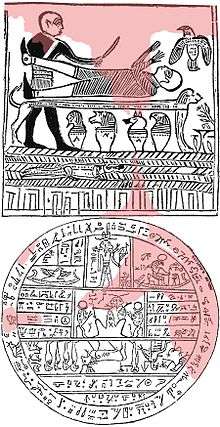
Several Egyptologists, including Deveria, Klaus Baer, Richard Anthony Parker, and Albert Lythgoe noted that portions of Facsimile No. 1 appeared to be incorrectly depicted—based on comparison with other similar Egyptian vignettes—and suspected that they had been reconstructed from lacunae (i.e. gaps) in the original papyri; Larson notes, "[S]ome elements in several of the drawings appeared to Deveria to be guesswork, probably incorrect restorations of missing sections of the original papyri."[77] Indeed, when the original papyri were later discovered, a comparison of the facsimiles with the papyri and the Kirtland Egyptian Papers revealed that the areas on Facsimile No. 1 which Egyptologists claim look modified (e.g. the heads of "the idolatrous priest" and the "angel of the Lord", the priest's knife) are the same sections that are missing from the extant fragment (i.e. Fragment I).[118][121] This lent credence to the Egyptologists' conclusions that Smith filled in these areas himself.[57][122][123][124]
Egyptologists have also criticized Facsimile No. 2 for containing false reconstruction of lacunae, suggesting that Smith reconstructed portions of the vignette with characters from another papyrus.[125] Critics note that an incomplete version of Facsimile No. 2 is found among the Kirtland Egyptian Papers, part of which are in Smith's handwriting. Comparing the published version of Facsimile No. 2 with the version from the Kirtland Egyptian Papers and the newly rediscovered papyri reveals that characters from a different papyrus fragment were used to fill in the missing portions of Facsimile No. 2.[125][126] Michael Rhodes notes:
A careful examination of Facsimile No. 2 shows that there is a difference between most of the hieroglyphic signs and the signs on the right third of the figure on the outer edge as well as the outer portions of the sections numbered 12–15. These signs are hieratic, not hieroglyphic, and are inverted, or upside down, to the rest of the text. In fact, they are a fairly accurate copy of lines 2, 3, and 4 of the Joseph Smith Papyrus XI, which contains a portion of the Book of Breathings. Especially clear is the word snsn, in section 14, and part of the name of the mother of the owner of the papyrus, (tay-)uby.t, repeated twice on the outer edge. An ink drawing of the hypocephalus in the Church Historian's office shows these same areas as being blank. It is likely that these portions were destroyed on the original hypocephalus and someone (the engraver, one of Joseph Smith's associates, or Joseph himself) copied the lines from the Book of Breathings papyrus for aesthetic purposes.[116]
Apologist responses to criticism of the facsimiles
Latter-day Saint Egyptologist John Gee, counters the idea that Smith reconstructed the lacunae by claiming that eyewitnesses of the papyri during Smith's lifetime described a complete document, free of lacunae. Thus, Gee argues that the facsimile is an accurate reproduction of an original document that has since suffered significant damage. Gee gives as an example "the man with a drawn knife", a portion that is no longer extant but was reported in both apologetic and critical writings of the time.[127]
Some apologists also believe that there are differences between the vignette and other comparable vignettes that render the standard interpretation incorrect.[nb 7] Apologists have also challenged the Egyptologists' means of successfully interpreting the facsimiles, arguing that the papyrus had likely been written, not for future Egyptologists or even contemporary Egyptians, but rather for Egyptian Jews. These apologists contend that the papyri may have been created by a Jewish redactor, adapting Egyptian religious sources, but imbuing them with new Semitic religious context. Apologists give examples of such Jewish adaptations to help explain how the facsimiles can support Smith's possible translation of the book.[45][129] Mormon apologists also allege the assertion that Smith's reconstructions were flawed—an assertion that has been put forth by several Egyptologists—is mere speculation that fallaciously presupposes that the Egyptologist interpretation is correct. These apologists therefore assert that Smith's reconstruction was either correct, was done so as to make the images more aesthetically pleasing, or was inconsequential to the original interpretation of the Book of Abraham.[116][nb 8]
Hugh Nibley of Brigham Young University notes that the seemingly misidentified characters in Facsimile No. 3 may have been participating in a ritual where both men and women can be represented by the opposite sex.[131] Nibley also argues that Smith's interpretation of the facsimile avoids making "romantic and quite unjustified conclusions" (e.g. identifying the seated person as Pharaoh, identifying the two feminine figures as Pharaoh's wife and daughter, or as Abraham's wife Sarah); instead, Nibley contends that Smith's interpretation of the facsimile is consistent with modern understandings of "the court scenes on other biographical or autobiographical records" (for instance, that the figure in the center of a stele is usually the owner or "usually some personal servant or palace officer attendant on Pharaoh", and that Smith indeed identified one of the central figure as a servant-cum-waiter named Shulem).[132]
Apologists also cite parallels between the scenes depicted on the facsimiles and several ancient documents and other Jewish writings, maintaining that there is no evidence that Smith studied or even had access to these sources. Examples include: the attempted sacrifice of Abraham and his subsequent rescue (a similar story was preserved in a Coptic encomium only translated into English in the 20th century),[133][134] Abraham teaching the Egyptians astronomy (this is recounted in the aforementioned Coptic encomium, and is mentioned by Eusebius, quoting Pseudo-Eupolemus, in his work Praeparatio evangelica),[134][135][136][nb 9] and God teaching astronomy to Abraham.[138]
Scripture-based criticism
A religious criticism brought forth by Charles M. Larson is that because God rebuked and punished the Israelites anytime they lapsed into paganism or mingled with the followers of other deities, and because the New Testament claims that "God does not use pagan or ungodly vessels to bear his Truth", the claim that the Book of Abraham was found in Egyptian (that is, pagan) religious documents conflicts directly with what is written in the Bible.[139]
Defense of the book
A number of theories have been presented in defense of the official LDS Church position that the work is a revelation from God, through Joseph Smith, which tells a true story of actual events from the life of Abraham. The most common of these arguments is that Smith interpreted the documents by revelation, rather than a standard "translation" of text from one language to another, in a process similar to his translation of the Bible.[66][140] In 2014, the LDS Church published an essay on its website which acknowledged that Joseph Smith's notes concerning the meaning of the Egyptian characters are inconsistent with "those recognized by Egyptologists today" and that "Mormon and non-Mormon Egyptologists agree that the characters on the fragments do not match the translation given in the book of Abraham."[135] However, the essay points out that it was not uncommon for ancient Egyptian vignettes to be placed some distance from their associated commentary, thus text adjacent to and surrounding facsimile 1 may not be a source for the text of the Book of Abraham.[135][141] The essay concluded that "the truth of the Book of Abraham is ultimately found through careful study of its teachings, sincere prayer, and the confirmation of the Spirit" and "cannot be settled by scholarly debate concerning the book's translation and historicity."[135]
Other apologetic arguments do not deny the meaning of the papyri as determined by Egyptologists, but in addition propose that the hieroglyphic text has some hidden meaning. Some apologists argue that there are other messages and meanings embedded in the text along with the Egyptologist's translations that are unknown to us.[nb 10] For many years, Hugh Nibley, for instance, preferred the argument that the Sensen text has two meanings: one that can be determined by standard translation (a "literal translation"), and another (a "secret meaning") that can only be divined, possibly with the help of a tool like the Urim and Thummim or one of the seer stones that Joseph Smith purportedly used to translate the Book of Mormon.[143] Similarly, Richley Crapo and John Tvedtnes proposed that the Sensen text may have merely been a mnemonic device, used "to bring to mind 'a set number of memorized phrases relating to Abraham's account of his life.'"[144][145][146][147][148][149] Crapo and Tvedtnes argued that, were one to compare the literal meaning of the hieroglyphic characters found in the Sensen text with the Book of Abraham, certain parallels could be found; for instance, the first hieroglyph found the in Sensen text means "this", and Crapo and Tvedtnes pointed out that the opening of Abraham 1:11 reads, "Now this priest had offered ..."[149] This argument was popular within LDS circles, but Klaus Baer criticized it because the supposed parallels offered were "related by no visible principle" and instead seemed to have been made ad hoc.[149]
Still other arguments concern the origin and nature of the Joseph Smith Papyri. In response to criticism that the documents are too young to have been written by Abraham, H. Donl Peterson argued that the papyri may be copies of an original which was either written or commissioned personally by Abraham, and thus the copies could be considered "by [Abraham's] own hand" in the sense that they were derived from an original.[150] A similar argument proposed by Michael Rhodes is that the facsimiles that are found in the Book of Abraham represent a corrupted version of a document originally written by Abraham, and Smith gave the interpretation of the original document.[151] Finally, Kevin Barney has proposed the idea that the facsimiles were not created by Abraham, but by a Jewish redactor many centuries later.[152]
In regards to the connection between the Sensen text and the Kirtland Egyptian Papers, some argue that a relationship exists only because the latter is a product of Smith's scribes (as opposed to Smith himself), who, out of personal curiosity, were trying to reverse-engineer the meaning of the Egyptian hieroglyphs. In other words, this hypothesis posits that the scribes wrote down the characters from the Sensen text and then, via speculation, attempted to match the characters with what had been revealed to Smith. However, Smith's own diary entries (as collected in the History of the Church) record that in July 1835, he was "continually engaged in translating an alphabet to the Book of Abraham", which suggests Smith was actively involved in the creation of the Kirtland Egyptian Papers, thus weakening this apologetic hypothesis.[153]
It has also been argued that the methodology used by modern Egyptologists to translate ancient records is unreliable and unstable, and therefore produces flawed and nonsensical translations. Thus, the modern translations of the Joseph Smith Papyri as produced by Egyptologists are not to be trusted. This line of thinking was used by Nibley in his 1975 book, The Message of the Joseph Smith Papyri. He wrote: "To the often asked question, 'Have the Joseph Smith Papyri been translated?' The answer is an emphatic no! What, then, is the foregoing? A mechanical transcription, no more ... What we have is a transmission rather than a translation of the text ... Though as correct and literal as we can make it, the translation in the preceding chapter is not a translation. It is nonsense."[154]
Finally, it has been proposed that the remaining papyrus fragments are only part of the complete original papyri.[76] Contemporary accounts refer to "a long roll" or multiple "rolls" of papyrus.[135] In 1968, Keith C. Terry and Walter Whipple estimated that the fragments constituted roughly one-third of Smith's original collection of papyri.[155] Later, in 2000, Mormon Egyptologist John Gee provided a graphical comparison of the relative extent of the known fragments to other complete examples of similar scrolls, which indicated the total at about twenty percent.[156] Others, however, have challenged this notion, contending that the majority of the papyri have been recovered. Andrew Cook and Christopher Smith, for example, argue that, based on a physical analysis of fragments from the scroll of Hôr, only 56 centimeters could be missing from that scroll. This contrasts with an LDS scholar's earlier estimate for the length of the missing portion.[157][158] Still others have suggest that fragments may have only been a starting point for reconstruction.[159][160] Royal Skousen has argued something similar, that Smith made a mistake when he connected the facsimiles to the revealed text. For Skousen, sentences referencing the facsimiles were interlinear or margin notes that were not part of the actual revealed text. As such, he believes the facsimiles themselves are not part of the Book of Abraham and are extracanonical.[161]
See also
- Mormon cosmology
- Criticism of the Latter Day Saint movement
- Criticism of Mormon sacred texts
- Kirtland Egyptian Papers
Notes
- Facsimile No. 1 and Chapter 1 through chapter 2 verse 18 are to be found in Volume III, No. 9, dated March 1, 1842; Facsimile No. 2 and chapter 2 verses 19 through chapter 5 are to be found in Volume III, No. 10, dated March 15, 1842; Facsimile No. 3 are to be found in Vol. III, No. 14, dated May 16, 1842.[35]
- Bidamon did not sell a small "'Book of Abraham' Translation Manuscript I", which he later passed onto his son, Charles. This item was eventually sold in 1937 to a collector of LDS artifacts named Wilford Wood, who in turn donated it to the Church in the same year.[36]
- Stephen Thompson notes that at least "four anachronistic names [are found] in the text: Chaldea, Potiphar, Egyptus, and probably Pharaoh".[67]
- Whoever created the correlation often failed to properly determine where the Egyptian characters began or ended, as many of the transliterated characters found in the "Egyptian Alphabet and Grammar" are either improperly split or inappropriately combined with elements of other characters.[74]
- Including: A. H. Sayce of Oxford University, W. M. Flinders Petrie of London University, James H. Breasted of the University of Chicago Haskell Oriental Museum, Arthur C. Mace of the Metropolitan Museum of Art in New York, John Punnett Peters of the University of Pennsylvania, C. A. B. Mercer of the Western Theological Seminary, Edward Meyer of the University of Berlin, and Friedrich Freiheer von Bissing of the University of Munich.[81]
- The name "Hôr" is rendered in some sources as "Horus".[95]
- Apologist Michael R. Ash has noted: "The late Klaus Baer, a non-LDS Egyptologist from the University of Chicago, claimed the Facsimile 1 and 3 are unusual and it would be erroneous to claim that dozens of similar examples could be found. 'Facsimile 3,' he went on to note, 'is not a judgment scene [as often claimed by critics] and exact parallels may be hard to find.'"[128]
- Rhodes says that "Baer's, Coenen and Quackenbur's assumption that the missing portion would show an erect phallus with a hawk above it representing the conception of Osiris is not likely since the figure on the couch is wearing a kilt. Also the position of the hand of Anubis would be where the erect phallus would be. In all representations showing Osiris with an erect phallus, he is nude."[130]
- In Praeparatio evangelica 9.17.2–9, Eusebius quotes Pseudo-Eupolemus, and the text reads: "And Abraham dwelt with the Egyptian priests in Heliopolis and taught them many things; and it was he who introduced astronomy and the other sciences to them, saying that the Babylonians and himself had found these things out, but tracing back the first discovery to Enoch, and saying that he, and not the Egyptians, had first invented astrology."[137]
- Michael D. Rhodes admits that "we can, with the help of other similar texts, reconstruct the text and figures of the Joseph Smith Hypocephalus with a fair degree of accuracy," but believes that, "we are still far from completely understanding the message which the Egyptians meant to convey by it. The text of the hypocephalus itself seems to be an address to Osiris, the god of the Dead, on behalf of the deceased, Sheshonk. As is the case with most Egyptian texts (especially religious text), it is full of references to matters either obscure or unknown to us, although undoubtedly clear to the Egyptians. Needless to say, much work is still to be done before we can fully understand the import of the Joseph Smith Hypocephalus, and hypocephali in general."[142]
References
Footnotes
- Smith (1842), p. 704.
- Ritner, Robert K., A Response to 'Translation and Historicity of the Book of Abraham', Signature Books, archived from the original on April 4, 2017
- Gee (2000a), pp. 4–6.
- "The Book of Abraham". churchofjesuschrist.org.
- Ritner (2013), p. 55.
- Ritner (2013), p. 61.
- Ritner (2013), p. 306.
- Ritner (2013), p. 326.
- Ritner (2013), p. 310.
- Chase (2014), p. 160.
- Abraham 1:1–4.
- Abraham 3.
- Abraham 2:10.
- Abraham 3:18–28.
- Abraham 4:1.
- Ritner (2013), p. 11.
- Ritner (2013), pp. 11–12.
- Rhodes (2005), pp. 1–2.
- Smith 1902, p. 236.
- Ritner (2013), pp. 14–15.
- Ritner (2013), p. 1.
- Ritner (2013), p. 15.
- Ritner (2013), p. 2.
- Gee (2000a), p. 3.
- Smith et al. (1902), p. 238.
- Jessee (2002), p. 86.
- Ritner (2013), p. 18.
- Ritner (2013), pp. 19–21.
- Ritner (2013), p. 21.
- Ritner (2013), p. 20.
- Smith (1990), p. 169.
- Gee (2000a), p. 5.
- Ritner (2013), pp. 19, 23–24, 31–32.
- Ritner (2013), p. 27.
- Smith (1842).
- Ritner (2013), p. 62.
- Peterson (1995), p. 16.
- Todd (1992).
- Duis (1998), p. 206.
- Ritner (2013), p. 66.
- Reeve & Parshall (2010), p. 269.
- Ritner (2013), p. 64.
- Wade et al. (1967), p. 64.
- Ritner (2013), p. 65.
- Barney (2006).
- Wilson et al. (1968), p. 67.
- Ritner (2013), pp. 65–66.
- Deseret News, Salt Lake City, November 27, 1967.
- Larson (1992), p. 54: "Dr. Nibley was not an Egyptologist, as he himself was first to admit ... shortly after learning of [the existence of the papyri], he had begun to study Egyptian in Chicago with Dr. John A. Wilson".
- G (1968), p. 40.
- Todd (1968), pp. 39–46.
- Wilson et al. (1968), pp. 67–99.
- Baer (1968), pp. 109–54.
- Ritner (2000), p. 97.
- Rhodes (2005).
- Gee (1999).
- Ritner (2003).
- Larson (1992), p. 61.
- Ashment (2000), p. 126.
- Rhodes (2005), p. 1.
- Baer (1968), pp. 116–17.
- Wilson et al. (1968), p. 98.
- Baer (1968), p. 111.
- Wilson et al. (1968), pp. 95–96.
- Nibley (1975), p. 3.
- Rhodes (1988), pp. 51–53.
- Thompson (1995), pp. 152–56.
- The source of Joseph Smith's quotes cited here are found in Smith (1842), p. 704 and Smith (1990), p. 169, respectively.
- For fragments: I–XI, see: Ritner (2013), p. 65. For the sources of Facsimile No. 2 and 3, see: Ritner (2013), p. 66.
- For fragments: I–XI, see: Ritner (2013), p. 65. For the source of Facsimile No. 2, see: Ritner (2013), pp. 66, 263. For the source of Facsimile No. 3, see: Ritner (2013), p. 66.
- Ritner (2013), pp. 61–66.
- Larson (1992), p. 66.
- Ashment (2000), pp. 121–22.
- Larson (1992), pp. 96–97.
- Wilson et al. (1968), p. 95.
- Larson (1992), pp. 129–34.
- Larson (1992), p. 25.
- Larson (1992), p. 26.
- Deveria apud Stenhouse (1873), pp. 510–19.
- Larson (1992), p. 27.
- Spaulding (1912), pp. 23–31.
- Spaulding (1912).
- Spaulding (1912), pp. 26–27.
- Spaulding (1912), p. 24.
- Spaulding (1912), p. 23.
- Larson (1992), p. 29.
- Webb (1915), pp. 30–31.
- Abraham 1:12.
- Ritner (2013), p. 58.
- Wilson & et al. (1968), p. 68.
- Baer (1968), p. 118.
- Wilson et al. (1968), p. 86.
- Deveria apud Stenhouse (1873), pp. 513–14.
- Ritner (2013), pp. 101–86.
- E.g. Marquardt (2017).
- "Facsimile No. 1". churchofjesuschrist.org.
- Ritner (2013), pp. 117–18.
- Ritner (2013), p. 117.
- Ritner (2013), p. 113.
- Ritner (2013), pp. 113–14.
- Ritner (2013), p. 114.
- Pinch (1995), p. 157.
- Ritner (2003), p. 263.
- "Facsimile No. 2". churchofjesuschrist.org.
- Ritner (2013), p. 271.
- Gee (1991).
- Ritner (2013), p. 268.
- Ritner (2013), p. 270.
- Ritner (2013), pp. 273–74.
- Ritner (2013), p. 274.
- Ritner (2013), p. 272.
- Parker apud Larson (1992), p. 107.
- Rhodes apud Larson (1992), p. 107.
- Ritner (2013), p. 275.
- Ritner (2013), p. 267.
- Rhodes, Michael D. (1996), The Joseph Smith Hypocephalus: Seventeen Years Later, Light Planet, archived from the original on August 22, 2017
- Thompson (1995), p. 145.
- Thompson (1995), p. 144.
- "Facsimile No. 3". churchofjesuschrist.org.
- Ritner (2003), pp. 176–77.
- Larson (1992), p. 155.
- Wilson et al. (1968).
- Baer (1968).
- Ritner (2000).
- Larson (1992), pp. 104–08.
- Wilson et al. (1968), pp. 96–98.
- Gee (2000b), pp. 175–217.
- Gee (1992), p. 100.
- Rhodes (2003).
- Rhodes (2005), p. 19.
- Nibley (1980), pp. 89–90.
- Nibley (1980), pp. 90–91.
- Tvedtnes, Hauglid & Gee (2001), p. 540.
- Gee (2011), pp. 137–56.
- "Translation and Historicity of the Book of Abraham". churchofjesuschrist.org.
- Tvedtnes, Hauglid & Gee (2001), p. 545.
- Eusebius, Praeparatio evangelica 9.17.2–9.
- Tvedtnes, Hauglid & Gee (2001), p. 544.
- Larson (1992), pp. 119–20.
- Rhodes, Michael; Gee, John (January 29, 2006). "Interview on KSL Radio on January 29, 2006". KSL (Interview). Salt Lake City.
- Davidson, Lee (July 8, 2014). "Mormon Essay: Abraham Scripture May Not Be Literal Translation". The Salt Lake Tribune. Archived from the original on August 24, 2017. Retrieved July 14, 2014.
- Rhodes (1977).
- Larson (1992), pp. 115–16.
- Crapo & Tvedtnes (1968).
- Crapo & Tvedtnes (1969a).
- Crapo & Tvedtnes (1969b).
- Crapo & Tvedtnes (1969c).
- Tvedtnes (1970).
- Larson (1992), pp. 117–19.
- Peterson (1995), p. 27.
- Rhodes (2003), pp. 115–23.
- Barney (2006), pp. 115–16.
- Larson (1992), pp. 121–29.
- Rhodes (1992), pp. 138–40.
- Terry & Whipple (1968), p. 116.
- Gee (2000a), pp. 12–13.
- Cook & Smith (2010).
- Smith (2011).
- Gee (1992), pp. 93–119.
- Rhodes (1992), pp. 120–26.
- Skousen (2019), p. 39.
Bibliography
- Ashment, Edward H. (December 2000). "Joseph Smith's Identification of "Abraham" in Papyrus JS1, the "Breathing Permit of Hor"" (PDF). Dialogue: A Journal of Mormon Thought. 33 (4): 121–6. Archived from the original (PDF) on January 19, 2011.CS1 maint: ref=harv (link)
- Baer, Klaus (November 1968). "The Breathing Permit of Hor: A Translation of the Apparent Source of the Book of Abraham" (PDF). Dialogue: A Journal of Mormon Thought. 3 (3): 109–54. Archived from the original (PDF) on January 19, 2011.CS1 maint: ref=harv (link)
- G, D. L (February 1968). "New Light on Joseph Smith's Egyptian Papyri: Additional Fragment Disclosed". Improvement Era. Vol. 71 no. 2. p. 40. Retrieved August 9, 2016 – via The Internet Archive.CS1 maint: ref=harv (link)
- Barney, Kevin (2006). "The Facsimiles and Semitic Adaptation of Existing Sources". In Gee, John; Hauglid, Brian M (eds.). Astronomy, Papyrus, and Covenant. Provo, UT: Brigham Young University. ISBN 9780934893763.CS1 maint: ref=harv (link)
- Chase, Randal S. (2014). Pearl of Great Price Study Guide. Washington, UT: Plain & Precious Publishing. ISBN 9781937901134.CS1 maint: ref=harv (link)
- Cook, Andrew W.; Smith, Christopher C. (2010). "The Original Length of the Scroll of Hôr" (PDF). Dialogue: A Journal of Mormon Thought. 43 (4): 1–42. Archived from the original (PDF) on June 11, 2016.CS1 maint: ref=harv (link)
- Crapo, Richley; Tvedtnes, John A. (October 1968). "A Study of the Hor Sensen Papyrus". Newsletter & Proceedings of the Society for Early Historic Archaeology (109).CS1 maint: ref=harv (link)
- Crapo, Richley; Tvedtnes, John A. (March 1969a). "Rediscovery of Smith Papyri Affects Book of Abraham". LDS Student Association Commentary.CS1 maint: ref=harv (link)
- Crapo, Richley; Tvedtnes, John A. (May 1969b). "Papyri Give Further Book of Abraham Insight". LDS Student Association Commentary.CS1 maint: ref=harv (link)
- Crapo, Richley; Tvedtnes, John A. (June 1969c). "The Hor Sensen Papyrus as a Mnemonic Device: A Further Study". Newsletter & Proceedings of the Society for Early Historic Archaeology (114).CS1 maint: ref=harv (link)
- Duis, Perry (1998). Challenging Chicago: Coping with Everyday Life, 1837–1920. Champaign, IL: University of Illinois Press. ISBN 9780252023941.CS1 maint: ref=harv (link)
- Gee, John (1991). Notes on the Sons of Horus. Foundation for Ancient Research and Mormon Studies.CS1 maint: ref=harv (link)
- Gee, John (1992). A Tragedy of Errors. Mormon Studies Review. 4. Foundation for Ancient Research and Mormon Studies. pp. 93–119. Archived from the original on August 24, 2017.CS1 maint: ref=harv (link)
- Gee, John (1999). The Ancient Owners of the Joseph Smith Papyri. Foundation for Ancient Research and Mormon Studies.CS1 maint: ref=harv (link)
- Gee, John (2000a). A Guide to the Joseph Smith Papyri. Provo, UT: Foundation for Ancient Research and Mormon Studies. ISBN 9780934893541.CS1 maint: ref=harv (link)
- Gee, Jon (2000b). "Eyewitness, Hearsay, and Physical Evidence of the Joseph Smith Papyri". In Ricks, Steven; Parry, Donald; Hedges, Andrew (eds.). The Disciple as Witness: Essays on Latter-day History and Doctrine. Provo, UT: Foundation for Ancient Research and Mormon Studies. ISBN 9780934893459.CS1 maint: ref=harv (link)
- Gee, John (2011). "An Egyptian View of Abraham". In Skinner, Andrew C; Davis, Morgan; Griffin, Carl (eds.). Bountiful Harvest: Essays in Honor of S. Kent Brown. Provo, UT: Neal A. Maxwell Institute for Religious Scholarship. pp. 137–56. ISBN 9780842528047.CS1 maint: ref=harv (link)
- Jessee, Dean (2002). Personal Writings of Joseph Smith. Salt Lake City, UT: Deseret Book. ISBN 9781573457873.CS1 maint: ref=harv (link)
- Larson, Charles M. (1992). By His Own Hand Upon Papyrus (2 ed.). Cedar Springs, MI: Institute of Religious Research. ISBN 9780962096327.CS1 maint: ref=harv (link)
- Marquardt, H. Michael (August 1, 2017). "Breathing Permit of Horus". XMission. Archived from the original on August 24, 2017. Retrieved August 24, 2017.CS1 maint: ref=harv (link)
- Nibley, Hugh (1975). The Message of the Joseph Smith Papyri: An Egyptian Endowment. Salt Lake City, UT: Deseret Book. ISBN 9781590385395.CS1 maint: ref=harv (link)
- Nibley, Hugh (1980). The Three Facsimiles from the Book of Abraham (PDF). Foundation for Ancient Research and Mormon Studies. Archived from the original (PDF) on August 24, 2017.CS1 maint: ref=harv (link)
- Peterson, H. Donl (1995). Story of the Book of Abraham: Mummies, Manuscripts, and Mormonism. Salt Lake City, UT: Deseret Book. ISBN 9780875798462.CS1 maint: ref=harv (link)
- Pinch, Geraldine (1995). Magic in Ancient Egypt. Austin, Texas: University of Texas Press. ISBN 9780292765597.CS1 maint: ref=harv (link)
- Reeve, W. Paul; Parshall, Ardis, eds. (2010). "Mormon Scripture". Mormonism: A Historical Encyclopedia. Santa Barbara, CA: ABC-CLIO. ISBN 9781598841084.CS1 maint: ref=harv (link)
- Rhodes, Michael (Spring 1977). "Translation of Fac. #2". BYU Studies Quarterly (3). Archived from the original on July 7, 2012. Retrieved August 20, 2016.CS1 maint: ref=harv (link)
- Rhodes, Michael (1988). "I Have a Question". Ensign. pp. 51–3. Retrieved August 20, 2016.CS1 maint: ref=harv (link)
- Rhodes, Michael (1992). The Book of Abraham: Divinely Inspired Scripture (PDF). FARMS Review of Books. 4. Foundation for Ancient Research and Mormon Studies. pp. 120–6. Archived from the original (PDF) on May 12, 2017.CS1 maint: ref=harv (link)
- Rhodes, Michael (2003). "Teaching the Book of Abraham Facsimiles". The Religious Educator. 4 (2): 115–23.CS1 maint: ref=harv (link)
- Rhodes, Michael (2005). The Hor Book of Breathings: A Translation and Commentary. Provo, UT: Brigham Young University. ISBN 9780934893633.CS1 maint: ref=harv (link)
- Ritner, Robert K. (December 2000). "The "Breathing Permit of Hor" Thirty Four Years Later" (PDF). Dialogue: A Journal of Mormon Thought. 33 (4). Archived from the original (PDF) on January 19, 2011.CS1 maint: ref=harv (link)
- Ritner, Robert K. (July 2003). "'The Breathing Permit of Hôr' Among the Joseph Smith Papyri". Journal of Near Eastern Studies.CS1 maint: ref=harv (link)
- Ritner, Robert K. (2013). The Joseph Smith Egyptian Papyri: A Complete Edition. Salt Lake City, UT: Signature Books. ISBN 9781560852209.CS1 maint: ref=harv (link)
- Skousen, Royal (2019). "Royal Skousen Fundamental Scholarly Discoveries and Academic Accomplishments" (PDF). humanities.byu.edu/. Brigham Young University. Retrieved 26 July 2020.CS1 maint: ref=harv (link)
- Smith, Christopher C. (Spring–Summer 2011). ""That Which Is Lost": Assessing the State of Preservation of the Joseph Smith Papyri". John Whitmer Historical Association Journal. 31 (1): 69–83.CS1 maint: ref=harv (link)
- Smith, Joseph (March 1, 1842). "Truth Will Prevail". Times and Seasons. Vol. 3 no. 9. Nauvoo, IL. p. 704. Archived from the original on May 30, 2012. Retrieved August 20, 2016.CS1 maint: ref=harv (link)
- Smith, Milan D. Jr (December 1990). "That is the Handwriting of Abraham" (PDF). Dialogue: A Journal of Mormon Thought. 23 (4): 167–9. Archived from the original (PDF) on January 20, 2011.CS1 maint: ref=harv (link)
- Spaulding, F. S. (1912). Joseph Smith, Jr. As a Translator: An Inquiry. Salt Lake City, UT: The Arrow Press. Retrieved August 3, 2016 – via The Internet Archive.CS1 maint: ref=harv (link)
- Stenhouse, T. B. H. (1873). The Rocky Mountain Saints. New York City, NY: D. Appleton and Company – via The Internet Archive.CS1 maint: ref=harv (link)
- Terry, Keith; Whipple, Walter (1968). From the Dust of Decades: Saga of the Papyri and Mummies. Salt Lake City, Utah: Bookcraft.CS1 maint: ref=harv (link)
- Thompson, Stephen E. (May 1995). "Egyptology and the Book of Abraham" (PDF). Dialogue: A Journal of Mormon Thought. 28 (1): 143–60. Archived from the original (PDF) on January 19, 2011.CS1 maint: ref=harv (link)
- Todd, Jay M (1968). "Background of the Church Historian Fragment". Improvement Era. Vol. 71 no. 2. pp. 39–49. Retrieved August 9, 2016 – via The Internet Archive.CS1 maint: ref=harv (link)
- Todd, Jay (1992). "Papyri, Joseph Smith". In Ludlow, Daniel (ed.). Encyclopedia of Mormonism. London, UK: Macmillan Publishers.CS1 maint: ref=harv (link)
- Wade, Glen; Tolk, Norman; Travers, Lynn; Smith, George D; Graves, F. Charles (Winter 1967). "The Facsimile Found" (PDF). Dialogue: A Journal of Mormon Thought. 2 (4): 51–64. Archived from the original (PDF) on January 19, 2011.
- Tvedtnes, John A. (April 1970). "The Use of Mnemonic Devices in Oral Traditions, as Exemplified by the Book of Abraham & the Sensen Papyrus". Newsletter & Proceedings of the Society for Early Historic Archaeology (120).CS1 maint: ref=harv (link)
- Tvedtnes, John; Hauglid, Brian M; Gee, John, eds. (2001), Traditions about the Early Life of Abraham, Foundation for Ancient Research and Mormon Studies.
- Wilson, John A.; Parker, Richard A; Howard, Richard A; Hewerd, Grant S; Jerald, Tanner; Hugh, Nibley (August 1968). "The Joseph Smith Egyptian Papyri" (PDF). Dialogue: A Journal of Mormon Thought. 3 (2): 67–105. Archived from the original (PDF) on January 19, 2011.
- Webb, Robert C. (1915). The Case Against Mormonism. New York City, NY: L. L. Walton – via The Internet Archive.CS1 maint: ref=harv (link)
External links
- Translation and Historicity of the Book of Abraham, from the LDS Church website
- The Pearl of Great Price (containing the Book of Abraham), from the LDS Church website
- Portion of the Book of Abraham Manuscript from the JosephSmithPapers.org
- Dialogue: A Journal of Mormon Thought, an independent Mormon journal with scholarly works on the Book of Abraham
Apologists' perspectives
- Book of Abraham project, which provides apologetic essays arguing in favor of the Book of Abraham
- Critical Analysis of the Hypocephalus, which argues for the validity of Smith's translations.
- Symbolism of the Book of Abraham, from MyEgyptology.net, a Pro-Mormon Website
- Joseph Smith as a Student of Hebrew, providing background information on Joseph Smith's use of Hebrew in, among other places, the Book of Abraham.
- The Jewish Origin of the Book of Abraham, providing a critical look at the origin of the Book of Abraham
- LDS FAQ: The Book of Abraham, an apologist's analysis of the Book of Abraham
Critical perspectives
- The Book of Abraham, a website "devoted to the idea that the Book of Abraham ... is not what it purports to be."
- ReligiousTolerance.org: The Book of Abraham, providing a brief history of the text and reaction from Egyptologists since 1860
- Solving the Mystery of the Joseph Smith Papyri, from Jerald and Sandra Tanner's newsletter archive
- The Book of Abraham Revisited, an essay by H. Michael Marquardt
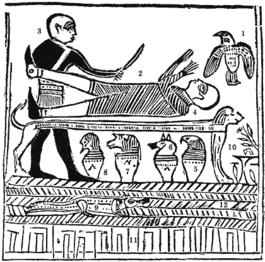
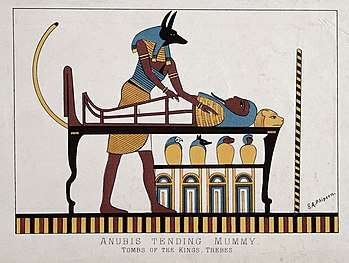
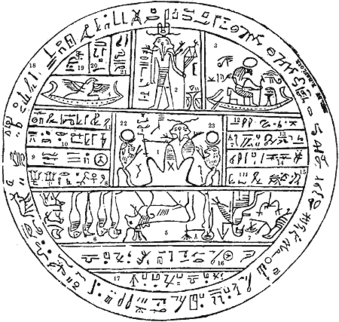
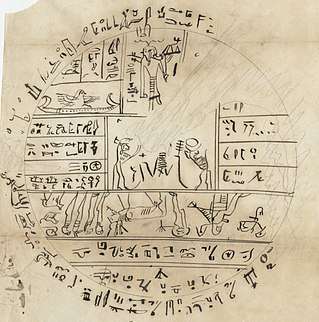
%2C_British_Museum%2C_London_-_20080821_-_Lines.png)
